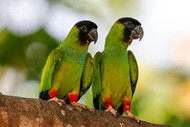Nanday Conure Fact Sheet
Posted by Nanday Conure, Nanday Conure Training, Nanday Conure Diet, Nanday Conure Behaviour, Fact Sheet on 9/1/2024
Rosemary Low explains more about the Nanday Conure in her fact sheet.
Scientific name:
Nandayus nenday
Common name(s):
Black-headed Conure
Adult length:
31cm (12in)
Adult weight:
140g
Expected lifespan:
25-30 years
Status in wild:
Common
For everything you need for your Nanday Conure please click here.
Origin:
Bolivia, Brazil, Paraguay and Argentina

Suitability / Screaming
Within the space of ten days, a friend rescued (bought!) an unwanted pair of Nanday Conures in poor condition, plucked and one unable to fly due to clipped wings, and a lady phoned me for advice about her Nanday.
A few days later I read a highly pertinent piece on the species in Australian Birdkeeper (April / May 2010 issue) by Jim McKendry — a Parrot behaviourist who writes good sense:
“Despite the super level of tactile interaction and trust that these guys can present to their keepers I would still never recommend one of these birds for an indoor pet environment.
I can’t imagine having a Parrot like Nandy [his Nanday] sharing the confines of an indoor dwelling and her vocalisations — particularly when deprived of human contact — not being an issue.
Calls
“She’s also highly reactive to the calls of any other bird or moving stimulus in her environment. In fact, the degree to which uncontrollable stimuli influence her calling behaviour has really served as a reminder for me of the challenges that often face Conure owners.”
How true this is! The lady who phoned me was at her wit’s end because her Nanday, apparently a female, would not stop calling. She had recently split up from her husband and moved three times in as many weeks.
The new landlord was already complaining about her Nanday. She had kept her for ten years and did not want to part with her. Obviously the Conure was as stressed as her owner and the bird was sensitive to the woman’s emotions. Combined with the rapid changes of location, the Conure had become extremely anxious and would not stop screaming when she went out to work (part-time).
How could she stop the Conure screaming? (Was the obvious question) Conures are gregarious birds that live in flocks. It is not natural for them to be out of earshot of their own kind.
Human
In the wild they are never alone. In captivity, the human companion replaces the mate so they continually call to be reassured that their companion is close by. This is normal behaviour — and quelling normal behaviour is almost impossible.

The owner mentioned that the Nanday liked to go in a drawer — but her husband had not allowed this. We agreed that to keep the Conure busy, and to deter her from screaming, she should now be allowed to go into a drawer.
I also suggested that a cardboard box with an entrance hole should be placed in her cage. Both these items could quieten her down as she goes into nesting mode. I suggested that she should provide a calcium supplement as the stimulus to egg-laying would be present.
The conclusion from these experiences is that a single Nanday seldom makes a suitable pet.
A young hand-reared bird will be very sweet and affectionate but being hand-reared it will become very demanding of human attention as it matures.
But if you are deaf and have no neighbours it might be just the bird for you!
Transformation
Now back to the pair rescued by my friend. Under his good care their transformation was remarkable.
Seventeen days after he acquired them, both were nearly fully feathered. He attributed this to the fact that their diet was greatly improved (previously no fruit or vegetables), he added a calcium supplement and gave them access to an outdoor aviary on some rare sunny days.
Perhaps most importantly, they have a room to themselves with no disturbances. Unfortunately, he then had to keep them indoors due to concerns that neighbours would complain about their vocalisations.
In good feather, Nandays are striking birds with the blue sheen on the upper breast, red “socks” and jet-black head. Seen in a flock in their natural habitat, flying low across pasture in the Pantanal, and disappearing as they land in the grass, they are truly beautiful birds.

This, I suggest, is where they belong. It was a tragedy that so many were exported to Europe and the USA, where most ended up leading lonely and frustrated lives. Their low price meant they were never valued.
Aviary
Plumage is alike in male and female but the male is usually slightly larger, with bolder head and beak. Unwanted birds that are not tame are much happier in pairs in an aviary. Let them attempt to breed but don’t perpetuate the problem of unwanted Nandays. Replace their eggs with ceramic ones or use them as foster parents for other Conures.
Please click here for cages for a Nanday Conure.
Nanday Conure Diet
All Conures need plenty of fresh fruits and vegetables on a daily basis. I would suggest that they form 30% to 40% of the diet. Green leaves, such as those of young dandelions, spinach and Swiss chard are also enjoyed.
Seeding dock and spray millet make valuable additions to the diet. A Parakeet mixture plus some soaked or sprouted white or striped sunflower can form the basis of the diet. In the wild they feed on seeds, fruits, berries and buds, also palm nuts. Nandays spend some time feeding on the ground so must be searching for tiny seeds or grit.
Here is our choice of food for Nanday Conures.
Click here for everything you need for Nanday Conures.

